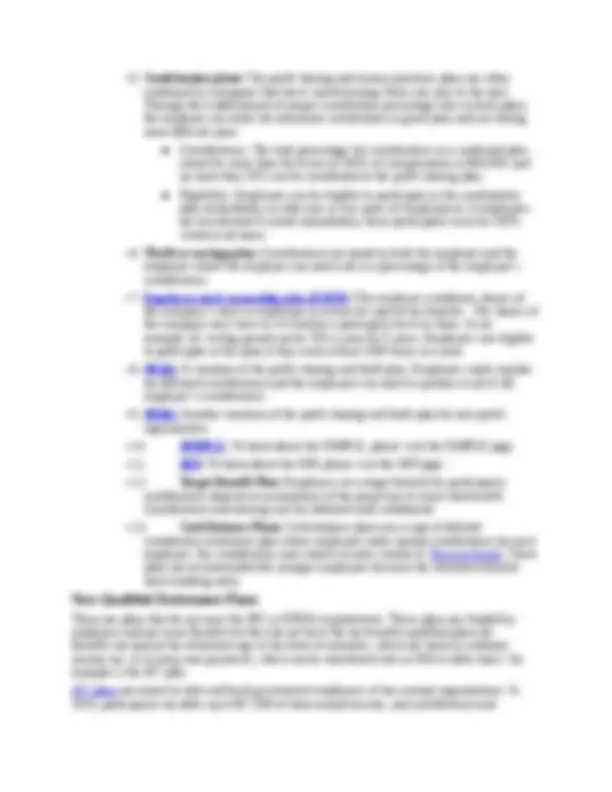




Study with the several resources on Docsity

Earn points by helping other students or get them with a premium plan


Prepare for your exams
Study with the several resources on Docsity

Earn points to download
Earn points by helping other students or get them with a premium plan
Community
Ask the community for help and clear up your study doubts
Discover the best universities in your country according to Docsity users
Free resources
Download our free guides on studying techniques, anxiety management strategies, and thesis advice from Docsity tutors
An overview of retirement plans, focusing on employer-sponsored plans. It covers the differences between qualified and non-qualified plans, including defined benefit plans (pensions, annuities), defined contribution plans (profit sharing, money purchase, combination plans, thrift plans, esops, 401(k), 403(b), simple, sep, and target benefit plans), and non-qualified plans (457 plans). Qualified plans offer tax benefits, while non-qualified plans are more flexible but do not have the same tax advantages.
Typology: Thesis
1 / 4

This page cannot be seen from the preview
Don't miss anything!



Among the different types of retirement plans, there are four main types: government-sponsored plans, personal plans, annuities, and employer-sponsored plans.
In the rest of this article, we will explore employer-sponsored plans in detail.
There are several types of qualified plans:
•.0. Pensions are a type of retirement plan that guarantees a specific amount to be paid out to the employee during retirement. The amount is calculated based on an employee’s salary, years of service and a fixed percentage rate. The Pension Benefit Guarantee Corporation (PBGC), a
federal agency, covers employer-sponsored pension plans. The insurance covers a monthly maximum amount of about $3,000 for a worker retiring at age 65. Eligibility depends on a company’s policy; some companies require service for a certain period of time before an employee can become eligible for a pension plan. If an employee leaves the job, the pension plan stays with the previous employer.
•.1. Annuities are defined benefit plans that have fixed monthly payments at the age of
retirement. Note that annuities cannot be transferred into an IRA account, so the amount is taxed as regular income the year it is received. There are different options for annuities:
■ Joint and 50%: The annuity is paid for life and after death, with the spouse receiving half of the amount for the rest of his or her life. ■ Joint and 66 2/3%: The annuity is paid for life and after death, with the spouse receiving two thirds of that amount for the rest of his or her life. ■ (^) Joint and 100%: The annuity is paid for life and after death, with the spouse receiving the full amount for the rest of his or her life. ■ 10-year certain & life: The annuity is paid for life; if the participant dies in the first 10 years of retirement, the beneficiary collects the same amount until reaching the 10th year of retirement at which point all payments stop. If the participant dies 10 years or more after retirement, the payments stop at the time of the death. ■ Life Only: The annuity is paid for life, and after death all payments stop. ■ Lump sum: The participant can take the total cash value of the retirement plan.
earnings are tax-deferred until withdrawal. Distributions start at retirement age but participants
can also take distributions if they change jobs or if they have an emergency, including death. Participants can choose to take distributions as a lump sum, annual installments or as an annuity. Distributions are subject to ordinary income taxes and the amounts cannot be transferred into an IRA.